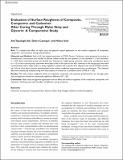Please use this identifier to cite or link to this item:
http://hdl.handle.net/11547/11245| Title: | Evaluation of Surface Roughness of Composite, Compomer and Carbomer After Curing Through Mylar Strip and Glycerin: A Comparative Study |
| Authors: | Topaloglu-Ak, Asli |
| Keywords: | IONOMER CEMENT |
| Issue Date: | 2020 |
| Series/Report no.: | 11;1 |
| Abstract: | Aim: To compare the effect of mylar strip and glycerin topical application on the surface roughness of composite, compomer, and carbomer during polymerization. Materials and Method: Each of 45 disc-shaped specimens of Z250, Dyract, Carbomer, were prepared according to manufacturer's instructions and molded in silicone rubber molds by one operator (5 mm diameter x 2 mm thickness; n = 135). Each restorative group was divided into 3 groups as oxygen group (control), mylar strip, and glycerin group (n = 15). In the control group, specimens were light cured in the open air for 40 s, whereas in the test groups they were covered either with a mylar strip or a drop of glycerin solution and cured for 40 s. Glycerin was rinsed off before polishing. Sof-Lex discs were used for polishing before the surface roughness measurements by a profilometer. The obtained data were statistically analyzed using two-way analysis of variance at a confidence level of 95% (P < .05). Results: The mean surface roughness values of composite, compomer, and carbomer polymerized in air, through mylar strip and glycerin showed no statistically significant difference (P > .05). Conclusion: Mylar strip and glycerin application did not affect the surface roughness of the composite, compomer, and carbomer. Polishing may mask the effect of different curing conditions. |
| URI: | http://hdl.handle.net/11547/11245 |
| ISSN: | 2320-2068 2320-2076 |
| Appears in Collections: | Web Of Science |
Files in This Item:
| File | Description | Size | Format | |
|---|---|---|---|---|
| topaloglu-ak-et-al-2019-evaluation-of-surface-roughness-of-composite-compomer-and-carbomer-after-curing-through-mylar.pdf | 571.26 kB | Adobe PDF |  View/Open |
Items in DSpace are protected by copyright, with all rights reserved, unless otherwise indicated.
